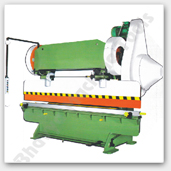 A press brake is primarily used for accurately bending various types of metal sheets and plates. Some frequently asked questions are as follows:
A press brake is primarily used for accurately bending various types of metal sheets and plates. Some frequently asked questions are as follows:
Q. What is camber?
A. Camber is actually a small piece of cap which is placed on the ram or bed to permit deflection. This is due to the fact that, any material which is bent on a it will encounter resistance. As a result this resistance will deflect the bed as well as the ram.
Q. Is it necessary to fasten the machine to the floor?
A. Definitely, the press brake must be first leveled and then properly fastened to the floor. Otherwise 25 percent of the energy of your press brake will be wasted, due to loss of torque.
Q. How much tonnage is required for a specific task?
A. Please refer the chart on the press brake which displays the amount of tonnage needed for a specific kind of metal. For example, you can press a 0.25 inch steel plate at 15.4 tons per foot. Further, in case you are using a 0.125 inch sheet, it can be pressed at 7.7 tons per foot.
Q. Explain tensile strength and yield strength for a press brake?
A. The term tensile strength is used when you are referring to pressing a metal piece. This includes applying lots of force at a particular place on the metal piece to accomplish the task. Whereas yield strength refers to applying relatively less force in order to roll a metal piece. Hence in order to press stainless steel or any other metal, you will require a larger press brake as the tensile strength is more than 80000. On the other hand, for rolling stainless steel, you may use a smaller capacity press brake. For example, a 304 stainless steel work piece actually has a tensile strength of 95000; while the yield strength is just 35000.
Q. Why is it essential to designate the various materials?
A. Material designation is important as well as mandatory, since it provides us the detailed information of a particular metal; including the tensile strength and yield strength. Moreover, it is also necessary to ensure that you have the complete designation of a metal. For instance, A516 is incomplete and not sufficient. You must also include the grade. Hence A516-55 means that the tensile strength is 55-75000 and the minimum yield strength is 30,000. And A516-70 refers to tensile strength of 70-90,000; and minimum yield strength of 38000.
Q. What is the maximum capacity of a press brake?
A. The maximum capacity is basically, the rated tonnage of the tools. Hence you should find out the relevant tonnage per foot, and then just multiply the tonnage by the number of feet you require. However, while using short pieces of metal, it is always advisable to slightly move the work piece in order to prevent the bed from getting damaged.
Hence these FAQs on press brake will help potential and existing users to solve their queries.





